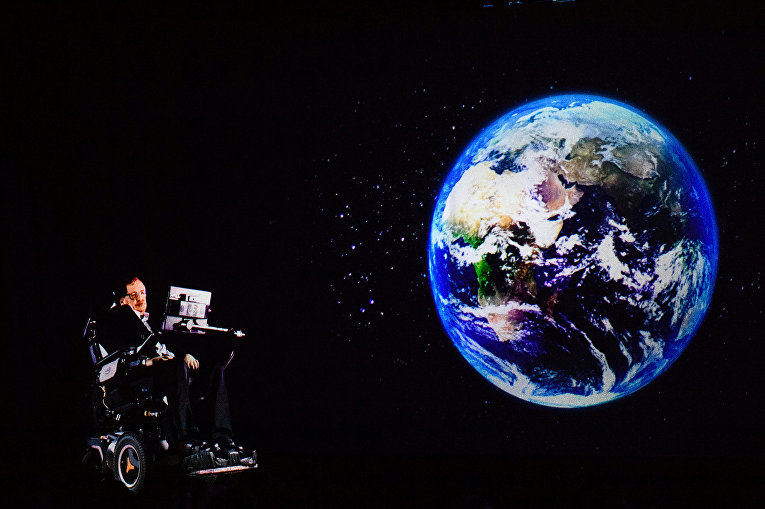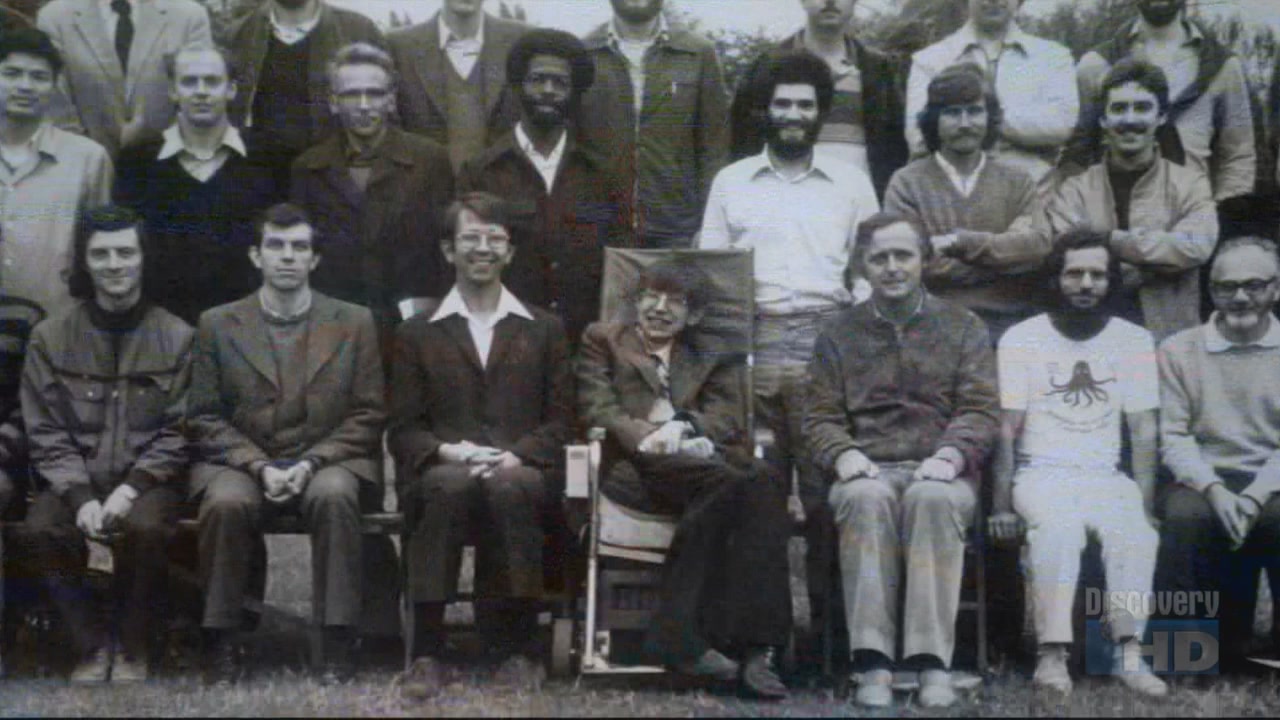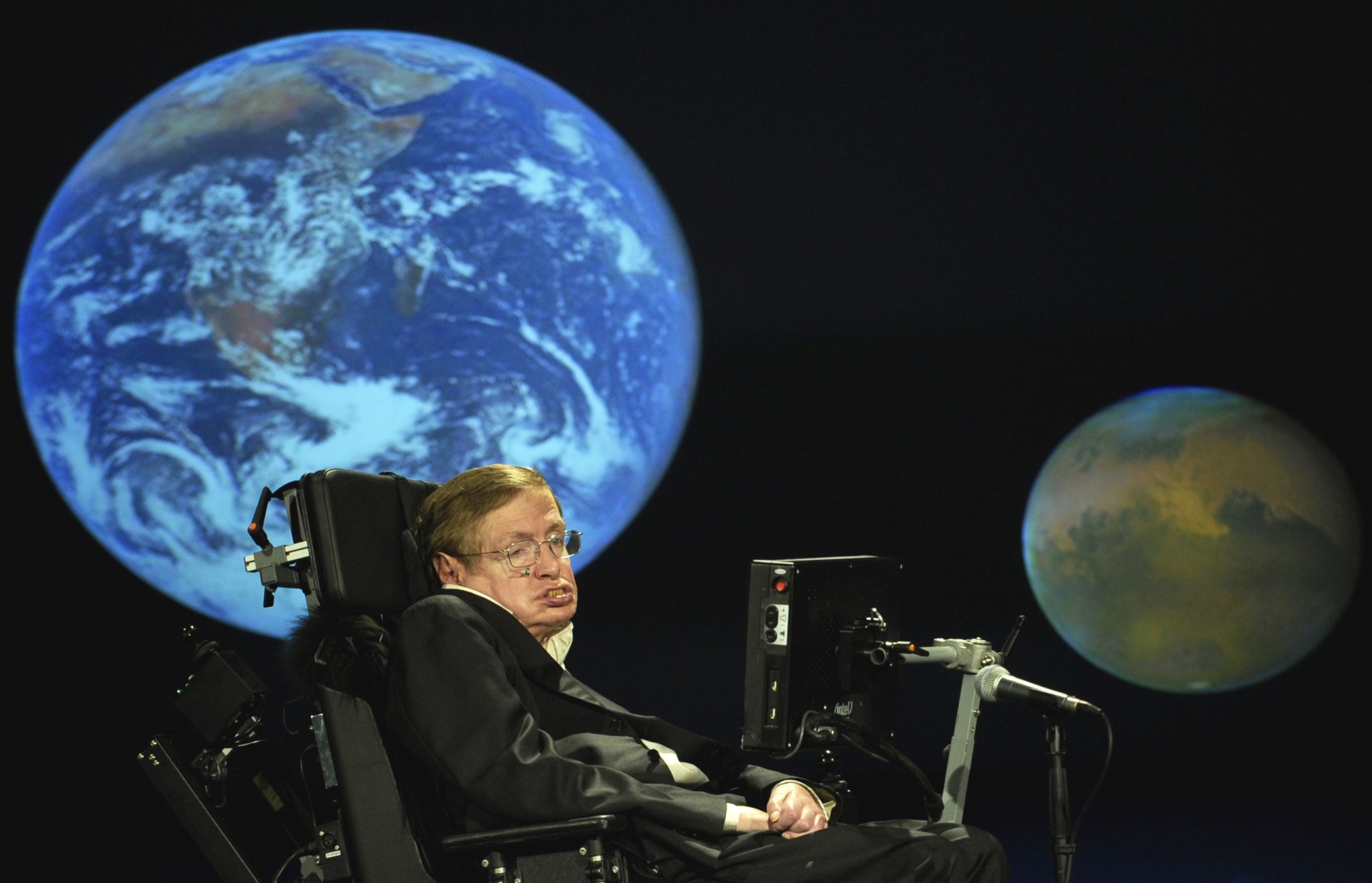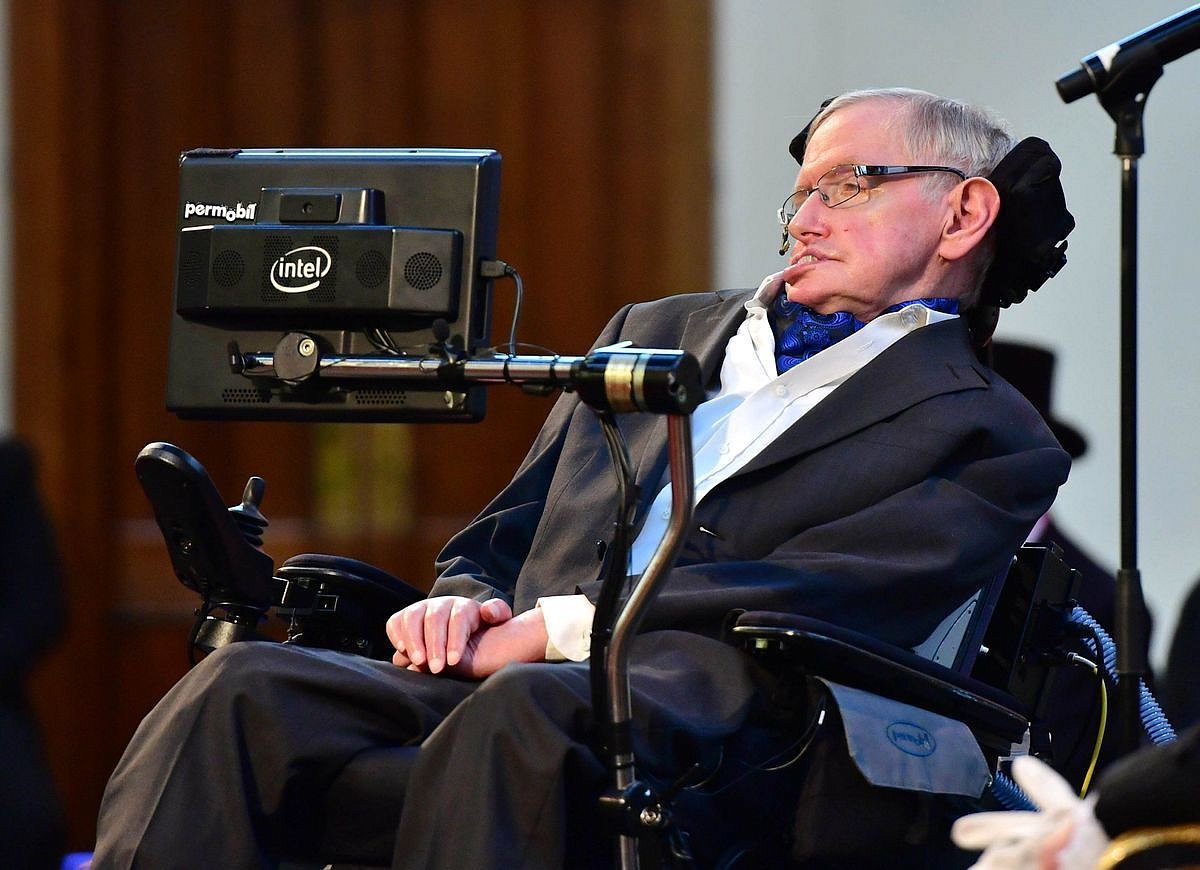Stephen Hawking and his work - what did the scientist give to humanity?

Hawking's speech in the form of a hologram to the audience in Hong Kong. The scientist was at this time with his own office in Cambridge
As it was already reported on Geektimes, one of the greatest scientists of the new time, the British theoretical physicist Stephen Hawking, passed away in his house this morning. He was 76 years old. Despite a serious illness, amyotrophic lateral sclerosis, Hawking lived almost a full life - spoke at conferences, appeared on television, even voiced himself in The Simpsons. But, of course, he gained notoriety not so much for his public activities, as for his scientific work. This article is devoted to the research and achievements of Hawking.
What kind of work and in what direction was the scientist digging? Why do so many speak about him and his books, concepts? Hawking is one of the founders of quantum cosmology. The scientist formed the theory of the emergence of the universe as a result of the Big Bang. In the course of his work, he made a large number of discoveries, including such a specific area as the evolution of stars. One of his first books, A Brief History of Time, became a popular science bestseller, even people who were very far from science read it.

')
In this material, biographical data is not very much, it is written in order to give an idea of the work of Hawking. True, for a better understanding of how outstanding he was, it is worth pointing out a few facts from the life of a scientist, just a couple of paragraphs.
Stephen Hawking was born on January 8, 1942 in Oxford. Despite his intelligence, he did not excel in his studies at school, like many scientists before him. Troechnik was Einstein. By the way, Hawking received the nickname Einstein from his schoolmates. After school, he entered the university, and during his studies, the doctors diagnosed Hawking with amyotrophic lateral sclerosis. Unfortunately, this disease is not treated, and the majority of patients with such a diagnosis die young.
The student's speech became less and less intelligible, it became difficult for him to walk, fine motor skills became a problem. However, the future eminent scientist continued his studies. In 1962, he graduated from university with a bachelor's degree in mathematics and physics. After the doctors diagnosed the disease, Hawking was given only two years - the doctors did not expect more.

However, the disease did not progress too quickly, and Hawking walked until the end of the 60s, after which he had to start moving in a wheelchair. In 1985, the scientist suffered pneumonia, after which he lost the ability to speak. It was then that he began to use a speech synthesizer. All this did not stop him from the chosen path - the path to knowledge.
In 1965, a young specialist began conducting research at the University of Cambridge at Gonville and Keese College. Just a year later, he received his Ph.D. After this, the activities of the scientist became very diverse. For example, he went to work at the Institute of Theoretical Astronomy. There, at the department of applied mathematics and theoretical physics, Hawking became a professor of physics and mathematics.
His career began just in the 60s, when the third “experiment” of a series of classical experiments was conducted, which confirmed the validity of the general theory of relativity by Albert Einstein. This experience showed a gravitational redshift — that is, a change in the frequency of light as the beam passes alongside a massive object, such as a star.
When the theory of Einstein was confirmed, scientists began to investigate its possible manifestations and consequences. For example, the dynamics of the expansion of the universe after going out of equilibrium. Also, many experts engaged in the study of black holes. This topic is also interested in Hawking. In the thesis, the scientist used the theorems formulated by his colleague, the British mathematician Roger Penrose. The merit of Stephen Hawking was that he applied these theorems to the entire Universe, explaining, in particular, gravitational signularities. They represent the phenomenon of space-time, attempts to apply the equations of the general theory of relativity to which give incorrect from the physical point of view of the solution.
Interestingly, it was Penrose who was able to explain the process of the emergence of black holes, associating it with a singularity. Penrose argued that an ordinary star turns into a black hole due to a gravitational collapse, which is accompanied by the birth of a special kind of surface. It can be called "trap".
It is clear that it is impossible to directly “study” black holes; therefore, it is necessary to offer explanations to various phenomena, making sure that this explanation is consistent with other phenomena and their manifestations, as well as with the general concept of space-time. In 1971, Hawking suggested that in addition to ordinary black holes, there are also microscopic objects with a mass of billions of tons but a volume not exceeding the volume of a proton.
Developing this theory, in the 70s of the last century, Hawking, together with scientists Brandon Carter and David Robinson, were able to put the evidence base under the hypothesis of the American physicist John Wheeler. According to him, isolated black holes described in the Schwarzschild space-time can be characterized by two parameters. The first is the mass and the second is the angular momentum.

In his work "The large-scale structure of space-time" Hawking with another scientist, John Ellis pointed out that the final stage of the evolution of a massive star is a black hole. That is, a collapse beyond the horizon of events, as a result of which a black hole forms, within which, in turn, a singularity is formed. Scientists argued that at the beginning of the evolution of the universe, there was also a singularity, which can be described as the beginning of all beginnings.
Many of Hawking's colleagues in the 60s of the last century tried to explain the formation and existence of black holes only by the methods of quantum mechanics and the provisions of the general theory of relativity. Hawking was one of the first, if not the first, began to apply thermodynamics . He managed to get an exact expression for the entropy of a black hole. In this case, Stephen Hawking took advantage of the work of the Israeli physicist Jacob Bekenshtein, who derived the relationship — the entropy of a black hole is proportional to its area.
In the 70s, Stephen Hawking met with a number of USSR scientists, including the famous physicist Yakov Zeldovich . The latter believed that black holes could easily emit photons. The thing is that on the horizon of events in a black hole pairs of virtual particles are formed. And one of them goes away from the hole, and the second falls into it. Using this promising idea, Hawking was able to calculate the thermal spectrum of a black hole. He got an interesting result. For example, the temperature of a black hole with a mass equal to that of the sun, is almost zero, only one millionth of a Kelvin. Because of this, black holes cannot be detected by conventional methods. But such objects deflect light rays when passing those near, which is indirect evidence of the existence of a hole in space. Modern astronomers determine the location of massive objects, including black holes, precisely because of this phenomenon.

After some time, Hawking, together with his colleague, scientist James Hartley from the United States, developed a concept according to which there are parallel worlds for which there is a single wave function. And the fact that we are seeing people is just one of the possible realities. This concept later migrated to the mass of science fiction works, the basis of which is precisely the theory of the multiplicity of realities.
Despite the fact that the body was becoming increasingly weak, the scientist's brain worked clearly and clearly. He continued to conduct scientific activities and active life. Unfortunately, over time, the scientist was able to control only one muscle of his body - the facial muscle of the cheek. Especially for Hawking, engineers have developed a computer control system based on a motion sensor. That is, the movements of the mimic muscles Hawking controlled the system.
He continued to work actively. Hawking published the work about which it was said above - “A Brief History of Time”. This work is translated into a large number of languages. The total circulation of the book is more than 10 million copies.
Hawking, by the way, was the first to declare that the information that was transferred to a black hole by objects that fell into it is not saved. True, then the scientist changed his mind, explaining that information is not lost, but is transformed into a form inaccessible to humans. The matter that enters the hole evaporates due to Hawking radiation. But the information is not stored inside the black hole, but on the horizon of events. Hawking explained this phenomenon with the help of a functional integral technique, which is taken over a space with a trivial topology .
“Black holes are not really so black as they are drawn. These are not the eternal prisons that represent them. Something may come out of them, and possibly into another universe. So, if you feel that you have fallen into a black hole, do not give up. There is a solution! ” Said Hawking in one of his lectures.
As for the other universes, Stephen Hawking and a number of his colleagues believed and believe that black holes can be tunnels in the "possession" of the universes. True, not all black holes, but only those that are large enough and rotate. True, having passed through such a tunnel, it is impossible to return to our universe. Interestingly, this concept also became the basis for a number of science fiction works.

By the way, despite the fact that the work of cosmologists is quite difficult to understand (and this is mildly said), the real structure of the world is even more difficult, because physicists and mathematicians try to explain only a part of the phenomena that we observe or believe that we are observing. The process of knowledge is infinite, like the Universe itself. It is impossible to hope that the structure of the universe will become clear to our descendants in a hundred or even a thousand years. But some moments become clear, and the fog of the unknown gradually dissipates, albeit little by little, revealing clear facets of Knowledge. And this is the undoubted merit of Stephen Hawking. After his death, the children of the scientist stated that he left a legacy to several generations at once. This is no doubt.
Source: https://habr.com/ru/post/374337/
All Articles